Often your own well or well is the only source of water for your home or cottage. Of course, water from the depths must be somehow extracted, for which several series of special hydraulic equipment have been developed. Today we will talk about the varieties pumping equipment and how to choose a pump for your home and garden.
What well parameters will be required for calculation
For each well, pumping equipment is selected individually. This approach is facilitated by both special operating conditions and the widely varying configuration of the plumbing system. The desired technical performance of a pump is determined by many factors, but first things first.
The height of the water rise is of primary importance and it directly correlates with the power of the pump. Of course, the design parameters of the well are far from real: the mirror can rise and fall down to a dynamic level. The maximum one-time water intake also tends to change over time, because the time for complete pumping can increase due to the seasonally increased flow rate.
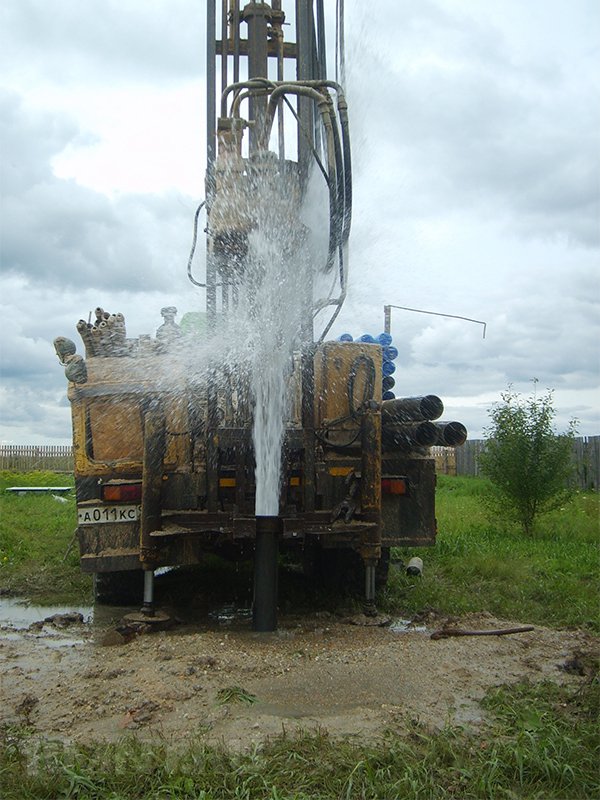
When calculating well equipment, it is the minimum expected flow rate that is of interest. Ideally, the well should never be completely empty, which means that the average daily water supply should be equal to or exceed consumption - this is the most favorable option. Therefore, the pump performance (flow rate in m 3 /h) should not be overestimated.
Pump selection by performance
This is the most problematic stage of selecting pumping equipment. If the well and system parameters are quite easy to correlate with the concepts of lift height, line length and desired operating pressure, then determining consumption at different periods of time is not so simple.
The reference point in this is the volume of drawdown of the well - the amount of water that can be taken from it at a time at zero flow rate. If the pump capacity is higher than the flow rate (and this is almost always the case), then the uninterrupted operation time is calculated by the ratio of the reduction volume to the difference between the inflow and the station capacity.

The mode of operation is also important water supply network, and well recovery rate. As a general rule, we can assume that water from the well is not pumped out for at least 4-5 hours a day, which means that the static level is completely restored. Therefore, a daily calculation will be sufficient.
The most pronounced periods of active water consumption are the use of toilets and watering crops on the site. Based on these periods of increased consumption, a general regime of use is drawn up, and the pump performance is selected. For example, a 150-liter bath should be filled three times per evening for each family member. With a well flow rate of 200 liters and a drawdown volume of 50 liters, it turns out that in order to be able to supply other consumers during this period, the pump productivity must be in the range of 250-300 liters per hour.

Along with the main consumers, secondary consumers can also be taken into account: cisterns, washing machines and the like. As amendments are added, the pump's performance can increase up to 700-1000 l/h, if simultaneous intake from all points is required. It is no longer possible to raise the performance bar any further: falling below the dynamic level is fraught with breakdowns due to dry running.
Compliance with well parameters
An interesting detail lies in determining the suction depth - one of the most important parameters pumping unit. Contrary to popular belief, this is not the absolute depth of immersion of the pump or suction filter into the well, measured from the surface, but the depth of the mirror at a dynamic level. It makes no fundamental difference to the pump at what depth it works, because the main work is done only by raising the water above the level of the mirror.
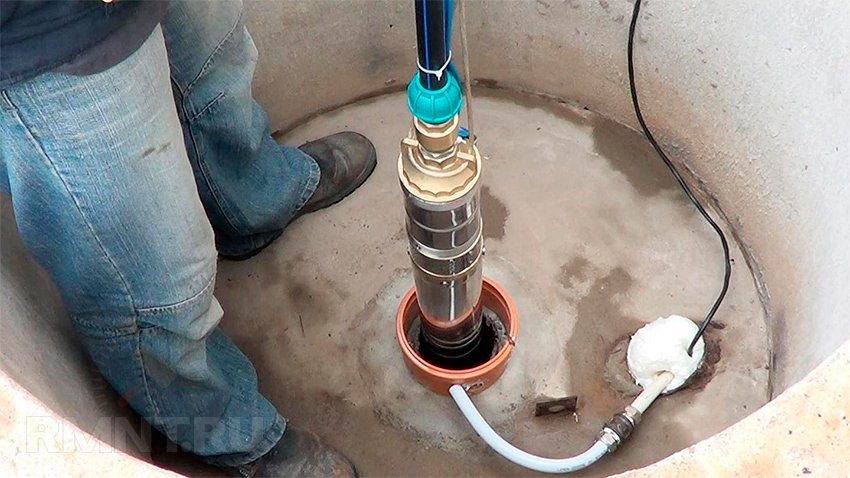
Another physical trick is that the depth of suction can vary in proportion to atmospheric pressure and altitude. The thinner the atmosphere, the less it contributes to extrusion. Due to this factor:
- Natural protection of the submersible pump from air entering the water supply is achieved.
- The advisability of placing an external pump at the lowest point of the system is explained.
The suction depth of surface pumps, as a rule, is very small: the maximum is 40-45 meters for advanced units with an external ejector operating in limestone wells. At the same time, pumps of a more traditional design can suck from a depth of up to 15 meters. It turns out that for wells of 20-30 meters the optimal class of equipment simply does not exist.
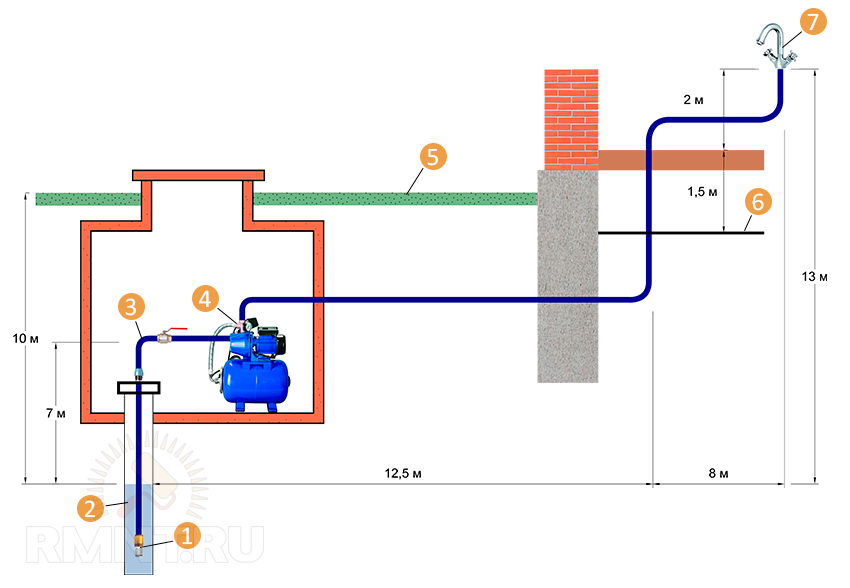 Data for calculating a pump for a well: 1 - check valve with filter; 2 - well; 3 - suction pipe; 4 - pumping station; 5 — ground level; 6 - basement; 7 - water consumers in the house
Data for calculating a pump for a well: 1 - check valve with filter; 2 - well; 3 - suction pipe; 4 - pumping station; 5 — ground level; 6 - basement; 7 - water consumers in the house
This may impose additional restrictions, for example if the maximum suction depth is above the dynamic level. If it is simply not practical to buy a more expensive station, you have to sacrifice the dynamic level and, as a consequence, the one-time reduction volume. This means that the adjustment for flow rate must be recalculated.
The height of the pump's discharge column is the difference between its installation level and the highest point of water intake. Please note that the hydrodynamic resistance of the system pipes cannot be neglected here. Unlike the relatively straight section between the suction filter and the pump, the outgoing line is characterized by a narrowing of capacity, numerous turns, fittings and shut-off valves. On average, power losses due to friction forces in pipes can reduce the declared lifting height by 10-30 meters.
Aspects of technical design
The choice of a pumping station looks completely different from the point of view of technical excellence and overall reliability. To navigate confidently, you need to have a good understanding of some of the details of the internal structure.
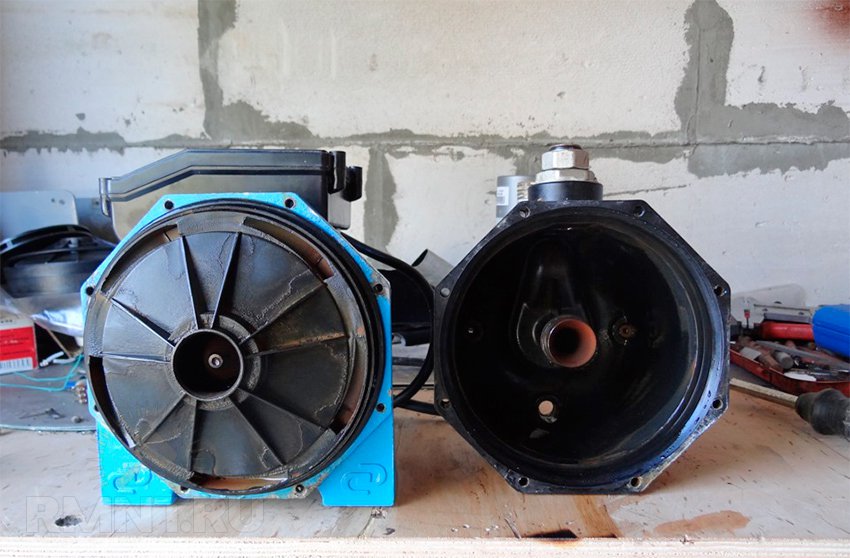
Let's start with the most common surface pumps with a suction depth of 7-10 meters. Inside they have a regular impeller, that is, the pumps operate due to the centrifugal force of spreading water. They are popular in pressure boosting systems, but such equipment should not be installed in a well (with the exception of Abyssinian ones).
A pump with an ejector unit is not critical to the presence of air in the system at a concentration of up to 50%. This makes it easier to automatically drain water from the main in winter and allows you to increase the suction depth to 15-20 meters. A remote ejector, as mentioned, doubles this figure, but at the same time the complexity of the pump and its piping increases by an order of magnitude, and therefore the potential number of breakdowns of low-quality equipment increases.
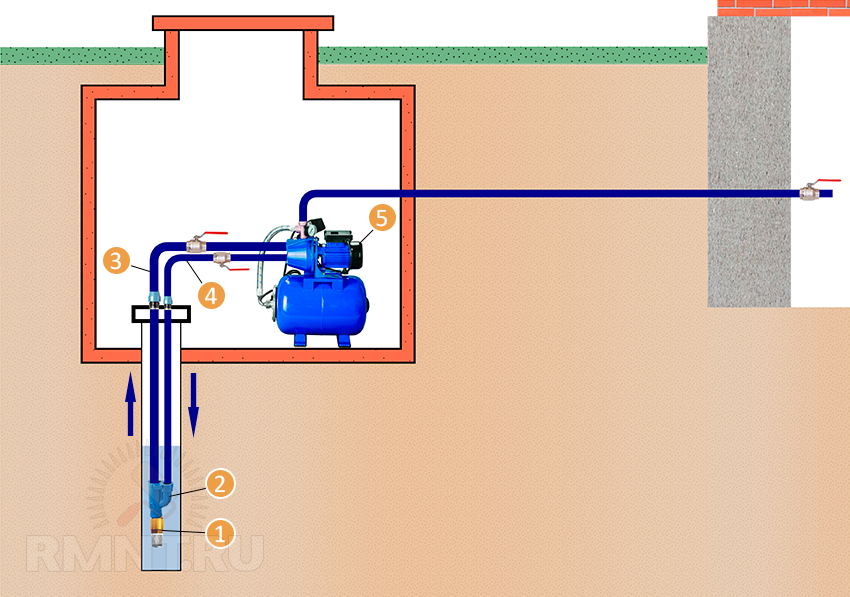 Pumping station with a remote ejector: 1 - filter with check valve; 2 - ejector; 3 - suction pipe; 4 - supply pipe; 5 - pumping station
Pumping station with a remote ejector: 1 - filter with check valve; 2 - ejector; 3 - suction pipe; 4 - supply pipe; 5 - pumping station
The weakest points of most pumps are the housing parts, the plastic impeller, the motor manifold assembly and the automation. Hydraulic accumulators suffer from drying out of the rubber membrane and corrosion of the connecting pipes. When choosing, you are encouraged to study prototypes demonstrating internal structure equipment.
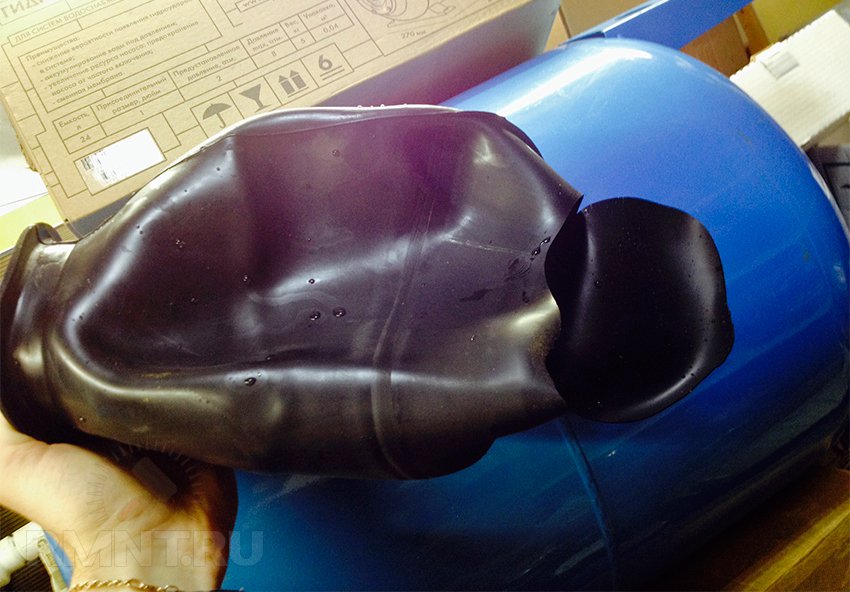
Submersible and surface pumps
As you may have realized, sometimes it makes sense not to consider the traditional pumping station as the only water supply option. Often it is hybrid versions of systems that allow solving specific problems.
The first thing you need for this is accessibility for placement in the well. submersible pump. Wells deeper than 40 m are initially designed only for this method of water extraction, but in shallower ones there may not be the necessary 130 mm to install a pump of the smallest size. We also must not forget that the pump reduces the available volume of water in the well, sometimes reducing uninterrupted operation time by more than an hour.
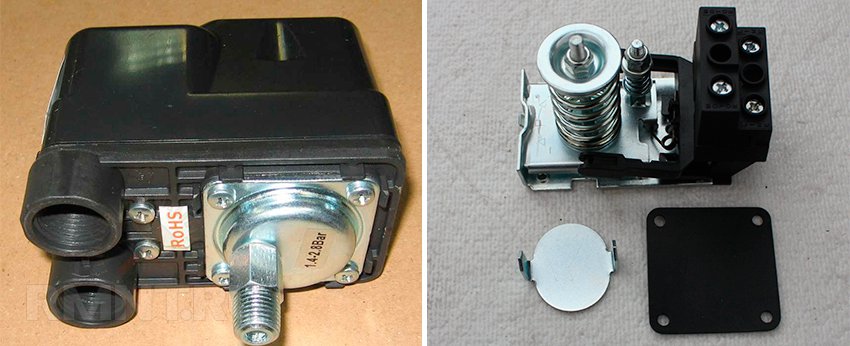
As for the automatic station, connecting a hydraulic accumulator with a pressure switch is also possible in this case. True, the system will be constantly filled with water, which means it must be thoroughly insulated. A more useful combination would be an electronic pressure regulator with an air release valve installed directly at the head of the well. The only additional cost for installing a hybrid station is the power cable, which must match the cross-section for such a significant length of the supply line.
Living in a private house is good, but if the water supply is arranged in the old-fashioned way, then everyday inconveniences can negate all the delights of country life.
A pumping station for a private home will not only handle the water supply to the house, it will also provide watering to the beds with vegetables and flowers. When calculating a pump well, take into account how deep the water is that will be supplied to the house, and how high the extreme point of water intake is located. It is also necessary to know the exact number of all water points (faucets, shower, toilet, washing machine, irrigation system). The simplest calculation of a pumping station consists of simply multiplying certain quantities. Let’s say the depth of water intake from underground is 10 meters, and the height of the highest point of water intake is 13.4 meters. Adding these two values and adding 10% for losses, we get 25.74 m. To this amount it is necessary to add 5 meters of the so-called “free pressure”, which is laid down for each individual water point. If there are five of them in the house, then we add 25 to 27.74. The result, which will be approximately 53, will give us the required number of liters of water per minute that should be provided water station in front of everyone open taps in the house.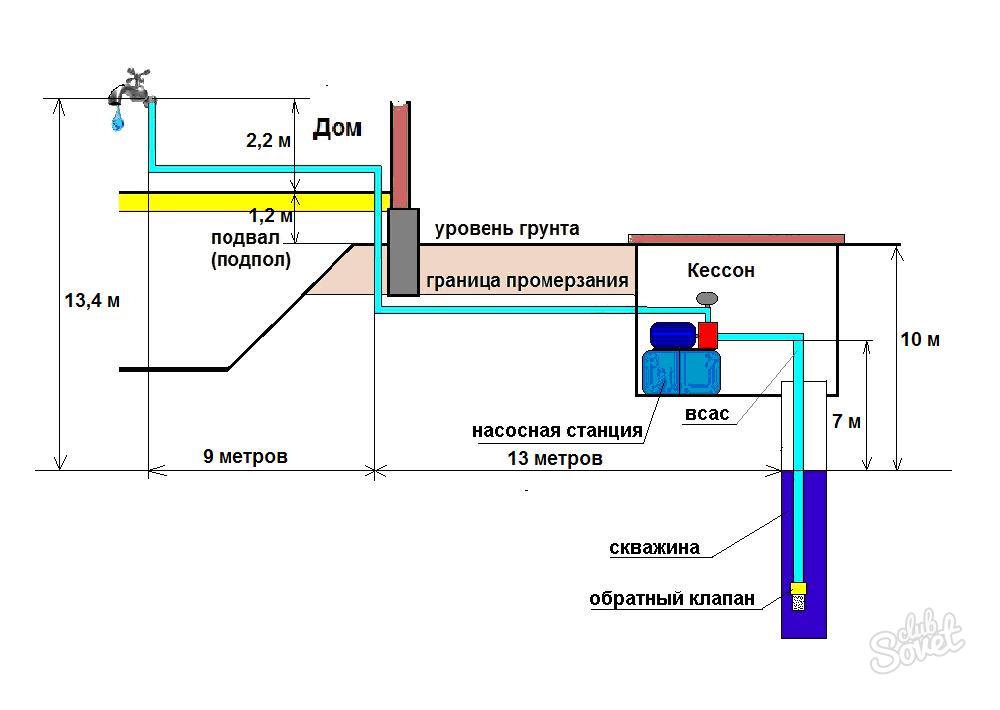
![]()
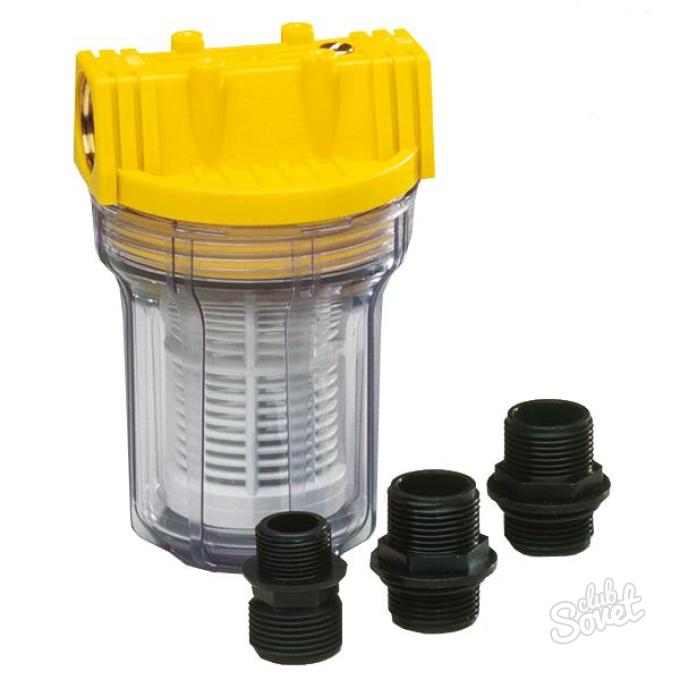
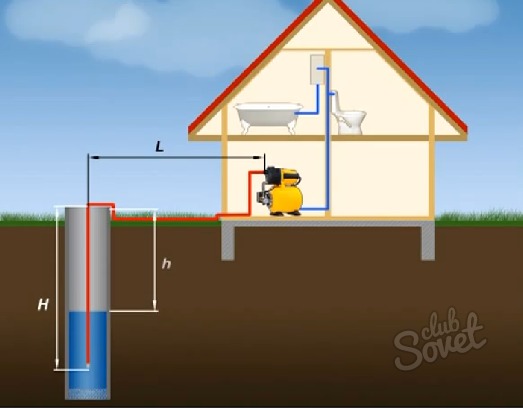
Modern water supply to a private home is quite feasible if the calculation of the pumping station is approached competently and with all responsibility.
An automatic pumping station is complex design, which is a complex of several jointly working devices designed to ensure uninterrupted water supply to a private home or site. The “heart” of such a station is a surface pump connected to an electric motor. Its work should be as autonomous as possible and occur without external human intervention. These functions are performed by other elements of the station: a hydraulic accumulator and an automation kit. When the system is operating, the pump pumps water from the source and supplies it to water points, the hydraulic accumulator serves as a reserve tank and maintains constant pressure, and automation is necessary to automate this entire process.
Today, a huge number of these devices are produced, so the question of how to choose the right pumping station is of particular relevance. To do this, you need to understand it functional characteristics, as well as in the properties of the elements included in its composition.
A pumping station is the most useful equipment for installing home plumbing
The main characteristics that should concern you as a buyer are the station pressure and water supply. Water supply (flow) is the amount of water that a pumping station can transport in a certain period of time. This characteristic should be close to the amount of water that pours out when all the taps in the house are turned on. Most models on the market are capable of a nominal flow in the range of 1.5-9 m 3 /hour.
Pressure is the distance over which the pumping station supplies water at rated flow. In the characteristics of the model, this figure is indicated in meters. In fact, the head of a station means the pressure it can create. For example, if the passport of a pumping station indicates a pressure of 45 m, then under ideal conditions it creates a pressure of 4.5 atmospheres. In fact, this figure will be somewhat less, since it is necessary to discard pressure losses when branching pipes, supplying water to the upper floors, etc.
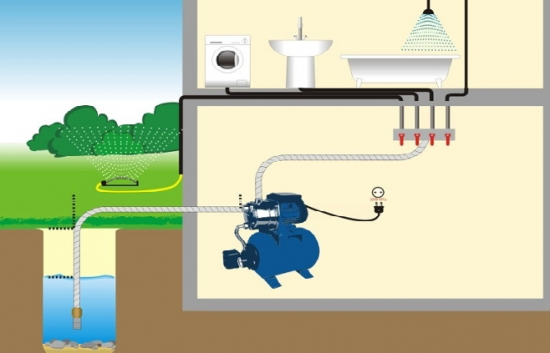
The pumping station can supply water to all water points in the house
It is difficult to accurately calculate these parameters on your own, and there is no great need for this. Any company that sells pumping equipment has specialists who can help you make calculations and select a station with the required parameters. The only thing you need to provide for this is a diagram of your home plumbing indicating the water points.
Design features of pumps and their types
When deciding which pumping station to choose, you should pay attention not only to the flow and pressure characteristics, but also to the design features. The main task of a water supply station is to pump water from the source and supply it to water collection points. This function is performed by a pump, so you should take a closer look at it. The following types of pumps can operate in water supply stations:
- self-priming
- multi-stage
- vortex
Self-priming pumps lift water from a depth of about 9 m and do not require filling the suction pipe with water. Their advantage is the ability to work in the presence of air bubbles in the pumped liquid. However, when turned on, they create a lot of noise, so it is better to install them in soundproofed rooms.
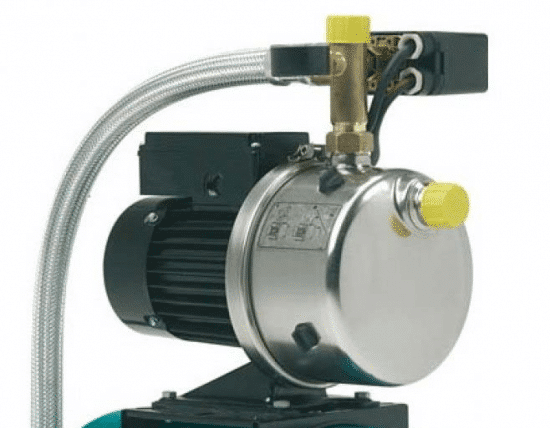
A self-priming pump as part of a pumping station can cause high noise levels
The multistage pump has lower noise levels and greater water flow than self-priming devices. However, a more complex design also determines the higher price of the product. Multistage pumps can be used if the water surface in your source does not exceed 8-9 m.
Vortex pumps lift water from a depth of up to 7 m, however, compared to the other two types, they have greater pressure. But the water supply (productivity) of the vortex device is less. The choice of a pumping station with a vortex pump is optimal when the depth of the water source is shallow or when it is necessary to increase the pressure in the water supply.
Pumping stations with a remote ejector
Having considered the characteristics of the pumps used in the stations, owners of deep wells or wells may be upset. After all, the height of water rise for these units does not exceed 8-9 m. How to choose a pumping station when the depth of the water surface in the source is more than 9 m and is this possible in principle? It is possible if you purchase a self-priming pump with a remote ejector. In this case, the station is installed, as usual, on the surface of the earth, and the ejector block is lowered into the well or borehole. This design can pump out water from a depth of 25-45 m.
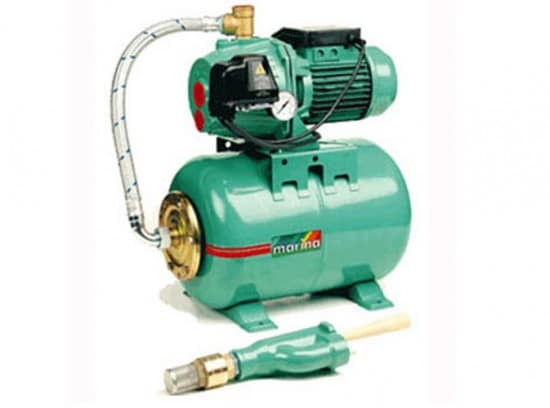
A pumping station with a remote ejector provides a water suction depth of up to 45 m
Hydraulic accumulator and its capacity
A sealed metal container with a volume of 24-1000 liters, on which the pump is mounted, is called a hydraulic accumulator. It allows you to reduce the number of times the pump is turned on, and will also provide you with an accumulated amount of water for a while during a power outage. Most often, pumped storage tanks are available in volumes of 24 and 50 liters.
Typically, buyers choose 24-liter models, as they are more compact and can be easily placed in any area of the house, for example, in the kitchen. However, it should be remembered that the smaller the tank volume, the more often the pump will turn on, and this, sooner or later, will lead to its breakdown. In addition, few people will like the noise of a running pump in the house, especially if it is repeated with enviable frequency.
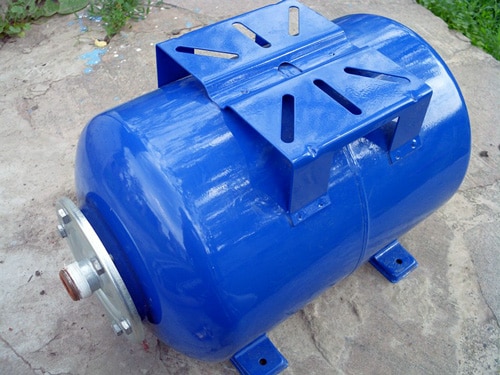
Most often, sellers of pumping stations offer a service such as equipping the selected device with a tank of any volume - all according to your desire.
Automation devices and their features
To automate water supply, the pumping station includes an automation kit. Its main element is a pressure switch, which turns on the pump at the lower pressure limit and turns it off at the upper pressure limit. These limits are set at the time of installation of the station and depend on the operating conditions of the device. For example, if the lower limit is set to 2 atm, then when the pressure drops to this figure, the pump automatically turns on, pumps up water and increases the pressure until the pressure reaches 3.5 atm. – upper limit. After this, the pump is turned off. A pressure gauge is used to determine the pressure in the system.
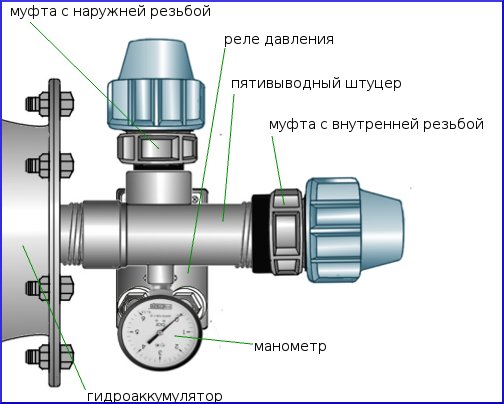
This is what the diagram of the automation kit of a classic modern pumping station looks like
The pumping station can also be equipped with other useful electronic devices that can stop the pump in the event of an emergency, protect the engine from overheating and dry running. Thus, when choosing a pumping station for your personal water supply, you should be guided not only by the technical parameters of the device. It is important to determine the preferred type of pump, the volume of the hydraulic accumulator and the automation kit, because from the right choice all components of the station will depend on the efficiency and durability of its operation.
In order to understand the method of operation of the pumping station and see with an example what it consists of, we recommend watching the video below.
Security country house the water supply system has become a necessary condition comfortable life. If the site has its own well or well, a pumping station for a summer residence is a reasonable and effective solution. Its presence is a guarantee of water supply to required quantity to any home water point. To choose the most optimal unit option for your home, you should get acquainted with its structure and operating principle.
Design and purpose of the unit
On suburban area Domestic pumping stations are used for the sole purpose of providing a residential building and the surrounding area with water from sources of any type: artificial (well, borehole) or natural (river, pond). Water is supplied either to special storage tanks, for example, for watering beds or garden trees, or directly to traditional water collection points - taps, faucets, toilets, geysers, washing machines.
Medium power stations are capable of pumping 3 m³/h. This amount of clean water is enough to provide for a family of 3 or 4 people. Powerful units are capable of flowing 7-8 m³/h. Power comes from the mains (~220 V) in manual or automatic mode. Some devices are electronically controlled.

Composition of the pumping station: 1 - expansion tank; 2 - pump; 3 - pressure gauge;
4 - pressure switch; 5 - anti-vibration hose
If you need an installation that can operate without human intervention, an automatic pumping station with an expansion (hydropneumatic) tank is suitable. Its composition looks like this:
- hydropneumatic tank (capacity volume on average from 18 l to 100 l);
- surface type pump with electric motor;
- pressure switch;
- hose connecting the pump and tank;
- electrical power cable;
- water filter;
- pressure gauge;
- check valve
The last three devices are optional.
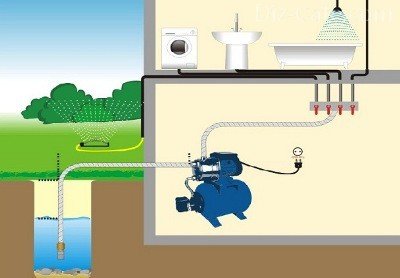
Installation diagram of a pumping station for a country house, provided that the water source (well, well) is located next to the building
Many summer residents prefer pumping stations because of their simple installation and full readiness for work. Protecting mechanisms from the human factor also plays a significant role. Before choosing a pumping station, we will consider in more detail the mechanisms on which its operation depends - the pump and hydropneumatic tank, as well as the possibility of electronic control.
Types of pumps
Designs of pumping stations for village and country houses imply the use of surface pumps that differ in the type of ejector - built-in or remote. This choice is based on the location of the device’s axis relative to the water surface. Pump power varies - from 0.8 kW to 3 kW.
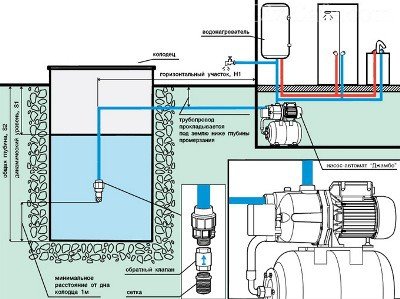
The choice of surface pump model depends on the depth of the water surface in the well
Models with built-in ejector
If the depth at which the water surface is located does not exceed 7-8 meters, you should choose a model with a built-in ejector. Water supply pumping stations with such a device are capable of pumping water containing mineral salts, air, and foreign elements with a diameter of up to 2 mm. In addition to a low sensitivity threshold, they have a high head (40 m or more).

Pumping station Marina CAM 40-22, equipped with a surface pump with a built-in ejector
Water is supplied through a rigid plastic tube or reinforced hose, the diameter of which is set by the manufacturer. The submerged end is equipped with a check valve. The filter eliminates the presence of large particles in the water. The first start of the pump should be carried out according to the instructions. Part of the hose up to check valve and the internal cavities of the pump are filled with water poured through a special hole with a plug.
The most popular models with a built-in ejector: Grundfos Hydrojet, Jumbo from the company Gileks, Wilo-Jet HWJ, CAM (Marina).
Devices with a remote ejector
For wells and wells, the water surface of which is located below 9 meters (and up to 45 m), water pumping stations equipped with devices with remote ejectors are suitable. The minimum borehole diameter is 100 mm. The connecting elements are two pipes.
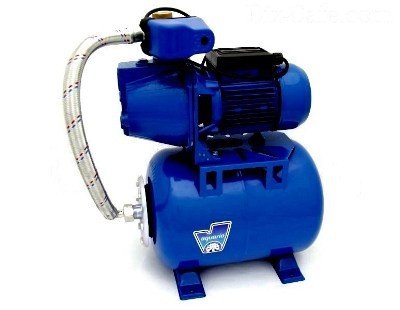
Pumping station Aquario ADP-255A, equipped with a surface pump with a remote ejector
Installations of this type require particularly careful installation, as well as careful handling: water with an excessive content of impurities or a broken strainer provokes clogging and equipment failure. But they have one advantage - they are recommended to be installed if the pumping station is located far from the well, for example, in a boiler room or in an additional extension near the house.
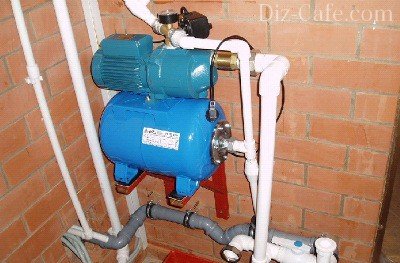
To protect the pumping station, it is installed in a utility room or heated room on the premises of the house.
Many characteristics of the pump - durability, noise level, price, stability - depend on the material of its body, which can be:
- steel - stainless steel looks beautiful, retains the properties of water unchanged, but has a high noise level, and the cost of such a device is higher;
- cast iron - pleases with a moderate noise level; the only negative is the possibility of rust formation, so when choosing, you should pay attention to the presence of a protective layer;
- plastic - advantages: low level noise, no rust in water, inexpensive; the disadvantage is a shorter service life than metal cases.
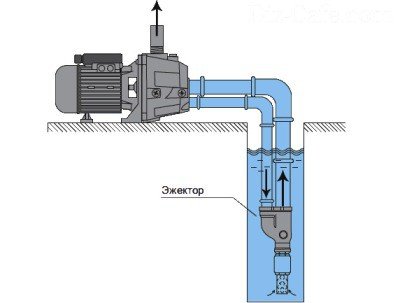
Installation diagram of a pumping station equipped with a surface pump with a remote ejector
Selection of hydropneumatic tank
Rating pumping stations for own dacha, you should remember the volume expansion tank, which performs several important functions. It helps regulate the pressure in the water supply. When one or more water points are turned on, the amount of water in the system will decrease, the pressure will drop, and when it reaches the lower mark (approximately 1.5 bar), the pump will automatically turn on and begin to replenish the water supply. This will happen until the pressure normalizes (reaches 3 bar). The relay reacts to pressure stabilization and turns off the pump.
In private homes, the volume of expansion tanks for pumping stations depends on the amount of water consumed in the system. The greater the water consumption, the larger the tank volume. If the tank has a sufficient volume and the water is turned on rarely, the pump will also turn on rarely. Volumetric tanks are also used as storage tanks for water during power outages. The most popular models are those with parameters of 18-50 hp. A minimum volume is needed when one person lives in the dacha, and all possible water points are located in the bathroom (toilet, shower) and in the kitchen (faucet).
Electronic control: double protection
Does it make sense to install electronically controlled equipment? To accurately answer this question, you need to consider the advantages of such stations.
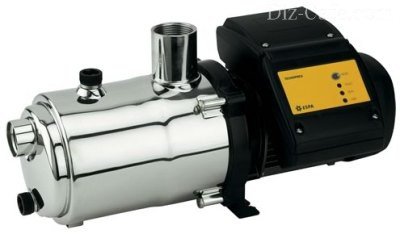
The electronically controlled ESPA TECNOPRES pumping station has an additional degree of protection
Functions controlled by the electronic unit:
- prevention of “dry running” - when the water level in the well drops, the pump automatically stops working;
- the pump reacts to the operation of water points - turns on or off;
- indication of pump operation;
- preventing frequent switching on.
A number of models, after the dry-running protection function, restart in the waiting mode for water to arrive. Restart intervals vary: from 15 minutes to 1 hour.
A useful feature is a gradual change in the speed of the electric motor, which is performed using an electronic speed converter. Thanks to this function, the water supply system does not suffer from water hammer, while saving energy.
The only disadvantage of electronically controlled models is their high cost, so such equipment is not available to all summer residents.
Before choosing the most suitable pumping station, you should carefully study technical specifications pump, expansion tank, as well as equipment installation conditions - and then the water supply system will work properly and efficiently.
To ensure water supply in a suburban area, the house is connected to a central water supply or to autonomous sources. These sources include wells and boreholes. To supply water to a private home, you will need a pumping station, a hydraulic accumulator and a reservoir for storing water supplies. In addition, it is necessary to install purification filters to protect the water source from contamination. To transport water into the room, steel, copper or polymer pipes are laid.
Specifics of water supply in a private house
For low water consumption, experts recommend using wells and a pumping station. The device presents a superficial automatic pump with tank. It is suitable for depths less than 8 meters. For greater depth, use a submersible pump in automatic mode. It will protect against sand in the pipes.
A well will cost less than a well. In addition, the equipment is easier to clean than a well. But due to low productivity, it will not be able to provide water to a large room. In addition, there is the possibility of drying out. For a large house and uninterrupted water supply, a well is installed.
Water supply pumping stations for a private home are selected depending on depth and performance, required pressure, estimated volumes of water consumption and price. For sand wells, pumps with a special filter are used that do not allow sand to pass through.
Pumping equipment is located next to the water source at a distance specified in the instructions. The pipes are laid below the freezing level of the soil. In the places where pipes are laid and the pump is installed, waterproofing is done and the space is insulated so that the water does not freeze in winter. Next, we will look at the types of sediment and learn how to choose the right device.
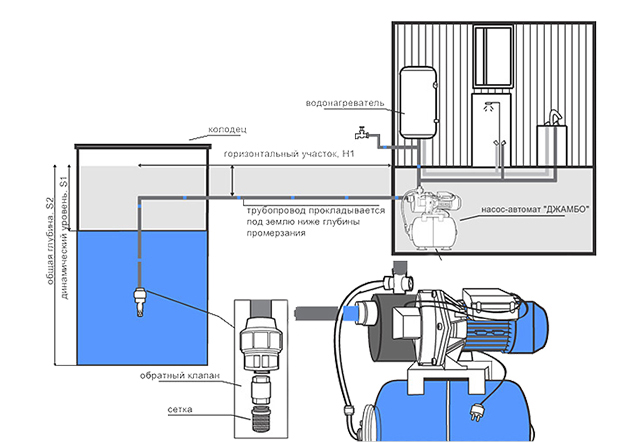
Connection diagram of the pumping station to the well
Types of pumping stations
When choosing a pump type, you will encounter a variety of equipment classifications. Let's look at each one. The water supply pumping station for the home is divided into devices with a remote and built-in ejector.
- A device with a remote ejector is lowered into the well up to fifty meters. Therefore, it is indispensable if groundwater is located deep. The low-noise pump can be installed inside the house. Among the disadvantages is the sensitivity of the device to sand and dirt, which clog and break the device;
- The built-in ejector pumps water from a depth of 8 meters. This pump is not afraid of dirt or sand. It does not fail if air gets into the structure. However, this is a noisy device, so it is not recommended to install the unit in the house.
Based on the type of water source, surface and submersible stations are produced:
- The surface pump is installed on the ground. A water hose or pipe is connected to the device, which is lowered into a well, well, tank, or other container. Such equipment is characterized by easy installation and operation. The pump is suitable for depths up to nine meters. The device must be installed in warm rooms, isolated from negative impact moisture;
- A submersible pump is more reliable and economical. The model with a waterproof case is completely immersed in water. Moreover, the immersion depth can be different and ranges from 10 meters.
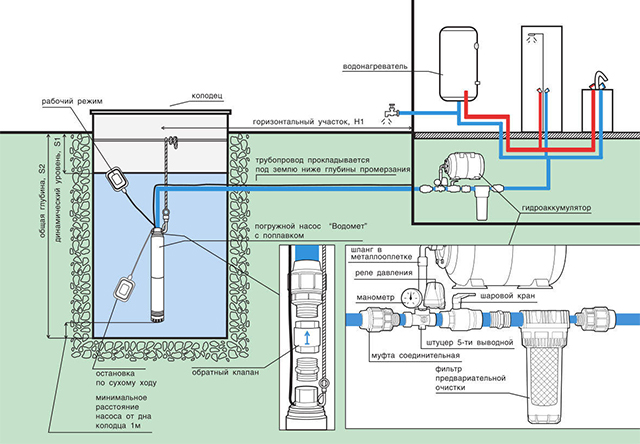
Connection diagram for a submersible pump to a well
Based on the type of water supply, a storage tank and a hydraulic accumulator (hydraulic tank or membrane tank) are distinguished:
- The storage tank is a separate container with a volume of up to 100 liters. The water level is monitored using a float valve. This is an economical and affordable device, but with large dimensions. Among the disadvantages, weak water pressure and the risk of flooding of the premises are also noted;
- A hydraulic accumulator or membrane tank is characterized by compact dimensions, easy installation and absence of leaks, and the ability to regulate water. But such a tank only holds about 25 liters of water.
In addition, there are borehole and well pumps. The well station is easy to install and operate, and is resistant to contamination. But they are less powerful and are only suitable for shallow groundwater. Well pumps are characterized by high performance and power. However, they are more demanding on water quality and less resistant to the influence of dirt or sand.
How to choose the right pumping station
When choosing, first of all, take into account the type of water source, the performance and power of the pump, and the capacity of the tank. If everything is clear with installations for wells and wells, then other parameters and dimensions need to be determined. Indicators depend on the area and purpose of the house. If the country cottage is planned to be used for permanent and year-round use, then the pump must be powerful and also resistant to frost.
- For a one-story private house with up to four people living, it is enough to use a hydraulic tank with a volume of 10-20 liters, a pump with a capacity of up to 4 m3/hour and a power of 0.8-1.2 kW/hour at a water depth of up to eight meters;
- For a two-story cottage, a hydraulic tank with a volume of 30-50 liters is used and a power of up to 2 kW/hour is selected;
- For a country summer house, which you plan to use only as a place for seasonal recreation, you can use a manually operated mini-station;
- For a house that will be used for year-round living, choose an automatic pumping station with self-adjustment;
- For high water levels up to 9 meters deep, silent surface models are used;
- When groundwater is deep, submersible devices with a built-in ejector are chosen. Of course, a pump with a remote ejector is quieter. But remember that such equipment cannot be installed in a source with silt or clay at the bottom. Otherwise, the device will become very and quickly dirty.

In many ways, the choice of pumping station determines the area and purpose of the building. By the way, there are many interesting projects and country cottages and country houses, you will find at the link http://marisrub.ru/proekts/all-proekts.
Top best pumping stations
| The best household models for country and garden houses | ||||
| Brand | Description | Minimum Price | Options | |
| NeoClima GP 600/20 N | Surface model with low pressure and water consumption, suitable for both wells and wells, has a thin hose and a short network drive | 5,800 rubles | 8 m | Immersion depth |
| 3 m3/h | Performance | |||
| 20 l | Tank volume | |||
| Quattro Elementi Automatico 801 | Surface pump for wells and wells, suitable for garden houses and cottages, is reliable and has a long service life, but the cleaning filter and valve must be purchased separately | 6,000 rubles | 8 m | Immersion depth |
| 3.2 m3/h | Performance | |||
| 20 l | Tank volume | |||
| AL-KO HWF 1000 | The package includes a coarse filter for purifying water from sand, leaves and other dirt; a “dry running” is provided, which prevents the pump from operating in the absence of liquid | 5,000 rubles | 9 m | Immersion depth |
| 3.2 m3/h | Performance | |||
| 20 l | Tank volume | |||
| GARDENA 3000/4 | Lightweight and silent household pump of surface type, but the installation cannot be stored at sub-zero temperatures, so the equipment is removed in winter | 7,200 rubles | 9 m | Immersion depth |
| 3.3 m3/h | Performance | |||
| 24 l | Tank volume | |||
| GILEX Jumbo 60/35 Ch-24 | A reliable surface pumping station at an affordable price, but difficult to operate and unstable to water hammer, so it is not recommended to open the tap suddenly | 7,200 rubles | 9 m | Immersion depth |
| 3.3 m3/h | Performance | |||
| 24 l | Tank volume | |||
| The best models for a country cottage | ||||
| Brand | Description | Minimum Price | Options | |
| VMtec Altera Auto 5/5 | Reliable automatic pump with installed filters for water purification, works without a hydraulic tank | 26,200 rubles | 30 m | Immersion depth |
| 8 m3/h | Performance | |||
| Wilo HMP 603 1 | Reliable surface station withstands water hammer and pressure surges, but without protection against “dry running” | 23,900 rubles | 30 m | Immersion depth |
| 8.1 m3/h | Performance | |||
| 50 l | Tank volume | |||
| Grundfos CMB-SP SET 3-47 | Surface pump with automatic control, protection against “dry running” and cycling, repairable, without hydraulic tank | 29,000 rubles | 8 m | Immersion depth |
| 3 m3/h | Performance | |||
| ESPA ACUAPLUS 5M N | Silent submersible pumping station, fully automated, provides uniform pressure and is suitable for several simultaneous water consumers, without a hydraulic tank | 35,200 rubles | 30 m | Immersion depth |
| 3 m3/h | Performance | |||
| Grundfos CMBE 1-75 | Surface station with fully automatic water supply and stainless steel tank, ensures stable water pressure | 59,600 rubles | 15 m | Immersion depth |
| 3 m3/h | Performance | |||
| 60 l | Tank volume | |||
If you don’t know which equipment is most suitable for your site, and how to properly install a pumping station, contact the professionals! Experienced craftsmen“MariSrub” will tell you how to choose and install a pump. We carry out a full range of works on the construction and finishing of wooden houses, as well as on the arrangement utility networks on plot of land. We guarantee high-quality reliable installation of water supply systems in a short time!





